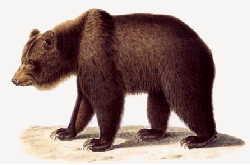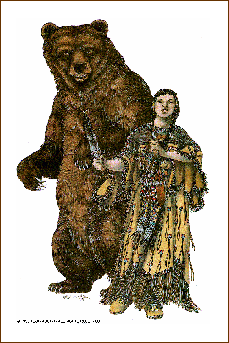
Bear Facts
Written and researched by Margaret nee Knight-Sypniewska, B.F.A.

- Bears are unpredictable.
- Bears crossed into North America about 500,000 years ago
- Don't ever think you can outrun a Bear. Browns have been clocked at over 45 mph over short distances.
- Grizzlies can sense winter storms days in advance. Over the winter they feed on the pine nut caches of Red Squirrels
- Grizzlies seldom attack people, and then it was only mothers protecting their cubs.
- Bears do not always hibernate for the entire winter. Many bears leave their dens periodically during a mild winter when food is accessible.
- Depending upon odor intensity and wind direction, brown bears can react to a scented object 400 or more yards away.
- Bear's broken claws manicure themselves during the sleep process. They are pointed and long when they leave their den in spring.
- While bears may not be able to spot stationary objects from a distance, they can spook at the sight of planes a half-mile away.
- A brown Bear's gait is faster than a man can walk, and when spooked, a Bear can maintain this pace for one or two miles.
- Bear food includes plants (wild rhubard, wild potatoes, skunk cabbage, hellebore shoots), insects, rodents, small animals, and occasionally carrion from the previous winter. They eat berries, mammals, and salmon in late summer.
- Grizzly bears feed on other bears that have died or have been killed.
- Bears usually try to avoid man. But some bears react very aggressively towards man's intrusion into their territory.
- Bear sows are ferocious, especially when they have cubs.
- "Nanook" is the Eskimo word for "polar bear."
- A mature brown Bear can open its mouth approximately five to six inches. Their foreclaws can reach 3 1/2 inchers in length.
- Bears are experts at breaking and entering cabins. They are attracted to food smells.
Never feed bears, they will come back for more food and DEMAND IT!!! - Most maulings last less than 30 seconds.
***** All across Turtle Island, Indians have honored bears. When hunters killed bears, they spoke to its spirit, asking for its forgiveness. The ritual for a slain bear was more elaborate than that for any other food animal.

The Brown Bear
Brown Bears used to be found all over the northern hemisphere. They included grizzlies, Russian Bears, and other types, all are noted for their large size and strength; they ranged from 6-9 feet long and from 450-1690 pounds in weight. Few animals would willingly challenge these powerful animals, and armed men do so warily. Bears hardly need the extra protection afforded by camouflage, except that they must sometimes rest. This is the time when bears are most vulnerable. Since bears are, by nature, forest dwellers, they have brown coat tones that match the color of tree trunks and bare ground. The coat of the brown bear is reddish-brown, and there is one race, living in Kashmir and the western Himalayas, that is red. All over the northern hemisphere brown bears have been hunted by men, ever since the beginning of human history. Bears often won over man, in the early days, but since the development of modern firearms, men have made bears either extinct or endangered. (Burton, Maurice and Jane, and Diane Hughes, World Encyclopdia of Animals London: Octopus Books, Limited, 1978.
).
At least two races of Grizzly (ursus arctos) are rare or endangered. They vary in color from pale yellowish-fawn to dark brown. They are large, immensely strong bears, and they are among the biggest carnivores. They live alone or in family groups and are active night or day, although in areas where bears have been persecuted, they are nocturnal. Their diet varies greatly from one area to another. Grizzlies are the most feared Bear. However, the chance of being mauled by a grizzly Bear are extremely small. Driving a car is three hundred times more dangerous than being around Bears in grizzly country. In the last twenty years, only ten people have been killed by grizzlies in the United States" ("Grizzly and Man, When Species Collide" by Jim Robbins(21-27)National Wildlife Magazine, Feb. - Mar. 1988.) Urcus Arctos horribilis, is the most dangerous of the 400 species of Bear protected under the US Endangered Species Act. At one time, the grizzly inhabited the entire West from Mexico to Alaska and their range extended eastward to western Minnesota. Before the white man came, the grizzly Bear was the undisputed ruler of the land. It roamed the prairie, feeding on vegetation and only occasionally on meat, usually carrion(Robbins).
Alaskan brown Bears feed heavily on migrating Salmon. Most are too slow to catch wild, hoofed mammals, although they have been known to kill bison, on occasion. Females breed every two or three years and produce litters of one to four young after a 6-8 month gestation. Newborns weight 10 1/2 to 25 ounces.
Indians feared bears most, because they were afraid of being mauled, maimed, or killed. Bears are noted for fierce maternal devotion. Bear cubs depend on their mothers. Bears are born blind, helpless, and hairless. Grizzly families remain together for three summers. Grizzlies inspire awe and respect. A griz is a warrior's warrior. In battle, a griz is powerful, aggressive, and fearless. Conjuring these qualities for themselves, warriors wore grizzly claws and painted bears on their shields. The primary reason for killing a Bear was for food. Indians also killed bears for their claws and hides. Shaman and warriors, who hoped to gain bear's powers, killed them and wore parts of them. Bear meat is rich and oily. Bear meat was boiled or roasted. Bears carry a thick blanket of body fat, this was used to provide grease for light. Bear skins provide parka ruffs, mittens, and blankets.
Shaman and warriors valued their claws, teeth, and skins. The eastern woodland tribes kept the tongue sinews, pieces of hide, knee bones, and scapulas as charms.
Bears mating rituals begin from late May to early July. Grizzlies are considered our closest animal relatives. Skinned bear carcass look human. The Ojibwa called bears humans.

Women who acquired the grizzly as a guardian were unusual. Some tribes fear Bear Women.
In the East, where there were no grizzlies, the black bear spirit was respected as a powerful vision. Woodland tribes generally hunted the Bear in his den while he was hibernating using only an axe or club. They spoke to the bear and after killing it, and called it grandfather
Bear doctors were herbal doctors who used plants (Rockwell, David, Giving Voice to Bear. Niwot, Colorado: Robert Rinehart Publishers, 1991).
Ceremonial Bear Items were:
Zuni Bear Fetishes.....Bear Effigy Pipes.....Bear Headdress.....Bear Claw Necklace.....Bear Paw necklaces.....Bear Shields.....Bear's Tongue.....Bear skin robes.....Bear Masks.....Bear Totem Carvings (wood).....Bear Paw Medicine Bags.....Tepee Covers (painted).....Painted Bear Skulls.....Bear's Bladder Sac.....Bear Pole.
They gathered nuts, ate maple syrup sugar, meat, walnuts, and berries [all favorites of bears]. They carved acorns, the symbol of the bear, on their war clubs.
The bear was a religious symbol to Native Americans. The Grizzly inspired awe and respect. The Griz was a warrior's warrior. Shaman believes they could turn themselves into bears. Bears and shaman are both solitary creatures. The eastern woodland Native American Indians employed shaman' bear powers to heal. Bear as their spirit helper. Bears ate the same foods as humans, even using heir medicines as food.
Bear Poaching:
Bear Poaching is illegal, as is the sale of Bear body parts. However, in Asia many animal parts are used for supposed medicines. Bear gall bladders have been used as medicines and aphrodisiacs for centuries. It has been suggested in the March 1999 Outdoor Life Magazine that perhaps if hunters sold them (the Asians) these parts that the poaching would be eliminated and thus less of the Bears wasted.
Much of North America has laws against this. Only Idaho, Maine, New York, Pennsylvania, and West Virginia currently allow the sale of Bear galls from legally hunted Bears. Connecticut, Louisiana, New Jersey, North Dakota, Oklahoma, and Rhode Island allow the sale of gall if it is taken out of state. In Canada, it is only legal in Nova Scotia and Saskatchewan.
An estimated 40,000 to 50,000 black bears are taken legally by hunters in the United States and Canada. Outdoor Life contends that selling legally obtained gall to the Asian market might eliminate the black market killings, since hunters generally do not use this part of the carcass.
I am not sure about this. It is a difficult situation. The magazine says that Asians also use powdered antlers as an ingredient. This need is solved by antlers from Elk raised on commercial farms specially for sales. Thus, Elk are not poached, like Bears.
I only remember that many animals, such as the Bison, were almost eliminated in the past, for their tongues. which were considered a delicacy in Europe. The tongue was taken and the rest left to rot. Where does it all end? In Bangkok they also have Bear Paw Soup which costs hundreds of dollars. Gall bladders get from $20-$250.00 depending on the state or province. However, they get less in places where such sales are legal. In the early 1900s, North American Black Bears were on the endangered species list. I might also mention that in Asia Bears are already near extinct, much like the quest for Elephant parts and Rhino parts
in Africa. This is an issue which needs closer examination.
LINKS:
Sign Petitions For Bears in Canada
This page was last updated on January 2, 2019
